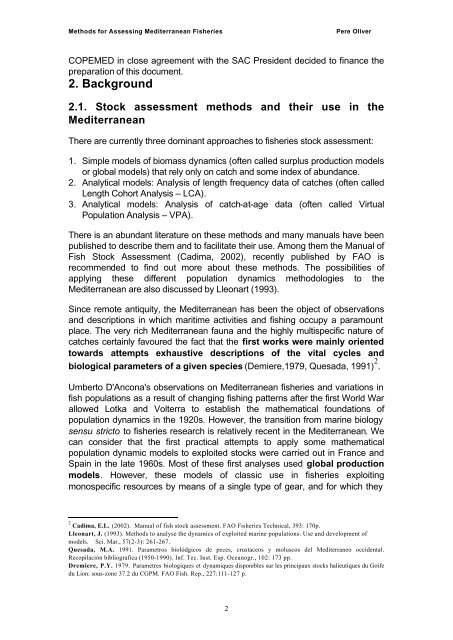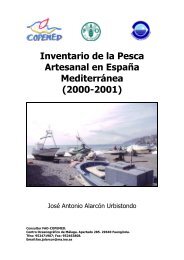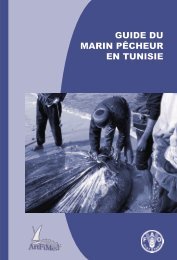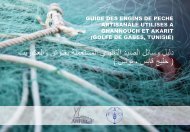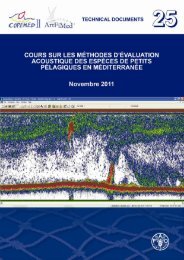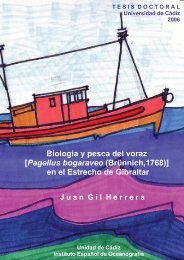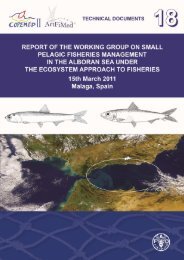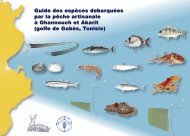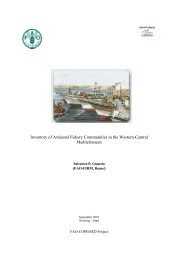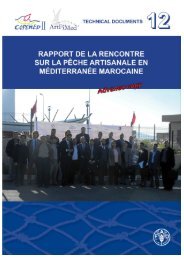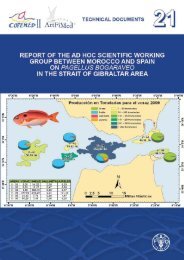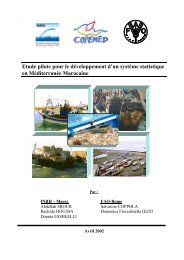Methods for Assessing Mediterranean Fisheries - Fao - Copemed
Methods for Assessing Mediterranean Fisheries - Fao - Copemed
Methods for Assessing Mediterranean Fisheries - Fao - Copemed
Create successful ePaper yourself
Turn your PDF publications into a flip-book with our unique Google optimized e-Paper software.
<strong>Methods</strong> <strong>for</strong> <strong>Assessing</strong> <strong>Mediterranean</strong> <strong>Fisheries</strong><br />
Pere Oliver<br />
COPEMED in close agreement with the SAC President decided to finance the<br />
preparation of this document.<br />
2. Background<br />
2.1. Stock assessment methods and their use in the<br />
<strong>Mediterranean</strong><br />
There are currently three dominant approaches to fisheries stock assessment:<br />
1. Simple models of biomass dynamics (often called surplus production models<br />
or global models) that rely only on catch and some index of abundance.<br />
2. Analytical models: Analysis of length frequency data of catches (often called<br />
Length Cohort Analysis – LCA).<br />
3. Analytical models: Analysis of catch-at-age data (often called Virtual<br />
Population Analysis – VPA).<br />
There is an abundant literature on these methods and many manuals have been<br />
published to describe them and to facilitate their use. Among them the Manual of<br />
Fish Stock Assessment (Cadima, 2002), recently published by FAO is<br />
recommended to find out more about these methods. The possibilities of<br />
applying these different population dynamics methodologies to the<br />
<strong>Mediterranean</strong> are also discussed by Lleonart (1993).<br />
Since remote antiquity, the <strong>Mediterranean</strong> has been the object of observations<br />
and descriptions in which maritime activities and fishing occupy a paramount<br />
place. The very rich <strong>Mediterranean</strong> fauna and the highly multispecific nature of<br />
catches certainly favoured the fact that the first works were mainly oriented<br />
towards attempts exhaustive descriptions of the vital cycles and<br />
biological parameters of a given species (Demiere,1979, Quesada, 1991) 2 .<br />
Umberto D'Ancona's observations on <strong>Mediterranean</strong> fisheries and variations in<br />
fish populations as a result of changing fishing patterns after the first World War<br />
allowed Lotka and Volterra to establish the mathematical foundations of<br />
population dynamics in the 1920s. However, the transition from marine biology<br />
sensu stricto to fisheries research is relatively recent in the <strong>Mediterranean</strong>. We<br />
can consider that the first practical attempts to apply some mathematical<br />
population dynamic models to exploited stocks were carried out in France and<br />
Spain in the late 1960s. Most of these first analyses used global production<br />
models. However, these models of classic use in fisheries exploiting<br />
monospecific resources by means of a single type of gear, and <strong>for</strong> which they<br />
2 Cadima, E.L. (2002). Manual of fish stock assessment. FAO <strong>Fisheries</strong> Technical, 393: 170p.<br />
Lleonart, J. (1993). <strong>Methods</strong> to analyse the dynamics of exploited marine populations: Use and development of<br />
models. Sci. Mar., 57(2-3): 261-267.<br />
Quesada, M.A. 1991. Parametros biolódgicos de peces, crustaceos y moluscos del Mediterraneo occidental.<br />
Recopilación bibliografica (1950-1990). Inf. Tec. Inst. Esp. Oceanogr., 102: 173 pp.<br />
Dremiere, P.Y. 1979. Parametres biologiques et dynamiques disponibles sur les principaux stocks halieutiques du Goife<br />
du Lion: sous-zone 37.2 du CGPM. FAO Fish. Rep., 227:111-127 p.<br />
2


